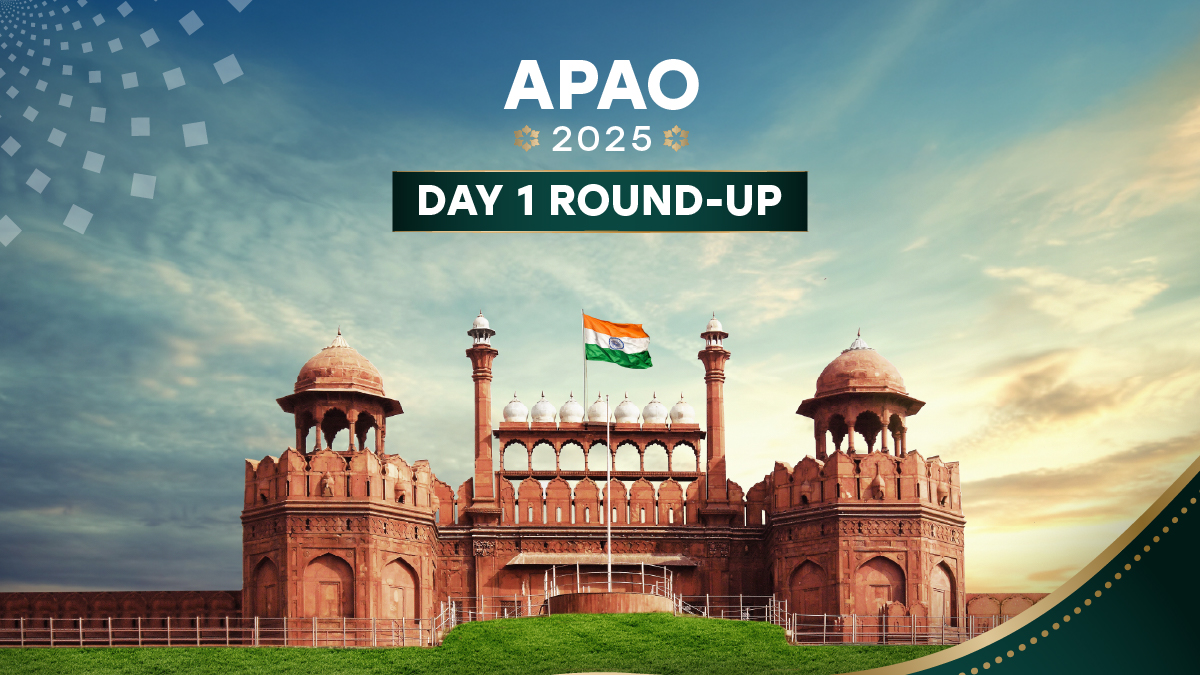New Delhi, new frontiers… here’s a look inside Day 1 of APAO-AIOC 2025
“India, a journey of the soul…” they say. Cliché as it may sound, I discovered its truth firsthand. My life-changing trip to India in September 2016—when I finally checked the iconic Taj Mahal off my bucket list—was nothing short of extraordinary—the first of many meaningful encounters connected to India.
My first encounter with an ophthalmology show daily for Media MICE (as we call our daily conference reporting) was a world away, at APVRS 2015 in Sydney, Australia.
It was July, mid-winter in the Southern Hemisphere. Even the constellations above felt unfamiliar in that upside-down world. As a Filipino unaccustomed to the biting cold, I felt like a fish out of water, clutching my newly acquired “winter coat”—a thoughtful purchase made possible by Media MICE’s “clothing allowance”. Finally, I had stepped into a country with a true four-season climate.
That was a decade ago… and as they say, the rest is history.
Fast forward to today, and I find myself in India once again (for the nth time, really!)—this time, not as a solo traveler but as part of a 12-member team from Media MICE’s satellite HQ in Da Nang, Vietnam. On April Fool’s Day, we landed in New Delhi, ticking off another bucket list moment—not just mine, but ours. I couldn’t be prouder.
Prouder still of Media MICE, of this incredible team of creatives, storytellers and visionaries who are reshaping the ophthalmic market in ways that truly matter. This is more than just a journey; it’s a movement, and we’re just getting started.
We’re just getting started indeed, and on Day 1 covering the 40th Congress of the Asia-Pacific Academy of Ophthalmology (APAO 2025) and the 83rd Annual Conference of the All India Ophthalmological Society (AIOC 2025) being held in New Delhi, India— from medical retina, keratoconus, artificial intelligence, retinal diseases, presbyopia and many more… we bring you the latest and the hottest.
“Controversies” in medical retina
Global retinal experts addressed various challenging topics, including retinal care delivery in India, the risks and benefits of red light therapy for myopia control, the gap between RCT results and real-world outcomes in anti-VEGF therapy for nAMD, the recognition of non-exudative choroidal neovascularization and adaptive optics insights in albinism.
Key issues highlighted include the challenges of providing retinal care in India due to high disease prevalence and limited resources, the potential retinal damage from red light therapy despite its efficacy, the difficulties in achieving RCT-level results in real-world nAMD treatment, and the importance of advanced imaging in diagnosing and managing conditions like neCNV and albinism.
The discussions emphasized the need for careful consideration of risks and benefits, accurate diagnosis, patient adherence and the integration of new technologies like AI in retinal care. Get all the details in the full article here.
The latest advances in retinal disease management
The latest advancements in retinal disease diagnosis and treatment were presented in a mid-day symposium at APAO-AIOC 2025.
Experts highlighted various topics, including extending anti-VEGF injection intervals for retinal vein occlusion, diagnosing masquerading conditions in retinopathy of prematurity (ROP) and tailoring ROP management guidelines for middle-income countries. Additionally, the symposium covered emerging therapies for inherited retinal diseases (IRDs), the use of AI for retinal screening in China and the ocular complications of cancer treatments.
The discussions emphasized the evolving landscape of retinal care, focusing on precision, access and vigilance. Key takeaways included the importance of early and sustained treatment for RVO, the need for comprehensive retinal examinations to avoid misdiagnosis in ROP and the potential of gene editing and pharmacologic modulation for IRDs.
Speakers in the symposium also highlighted the role of AI in improving diagnostic accuracy and accessibility, and the need for awareness of retinal toxicities from systemic therapies. Overall, the symposium showcased a shift towards earlier diagnosis, tailored interventions, and a deeper understanding of systemic factors in retinal care—read all about it here.
Beyond presbyopia
On the anterior segment front, presbyopia and presbyopia correction sessions never disappoint. At APAO-AIOC 2025, experts highlighted various strategies, including different types of intraocular lenses (IOLs) like refractive EDOFs and trifocals, each with its own benefits and drawbacks. A “mix-and-match” approach using different IOL types for each eye was also explored, as well as a live simulation tool to help patients choose the right IOL.
Additionally, speakers talked about emerging non-lens-based treatments such as laser scleral microporation and laser scleral therapy, which aim to restore the eye’s natural ability to accommodate by targeting the stiffening of the sclera.
The overall message is that presbyopia treatment is moving towards personalized solutions, with a focus on restoring function and improving patients’ quality of life, rather than a one-size-fits-all approach. Do not forget to read our full account of this session, here.
Bausch + Lomb brings SeeLuma to India
In the industry front, Bausch + Lomb launched its SeeLuma™ digital ophthalmic surgery visualization platform in India at APAO-AIOC 2025. SeeLuma, developed with Munich Surgical Imaging GmbH, features innovations like digital surgical binoculars, ergonomic design, and advanced visualization tools, aiming to meet unmet needs in digital ophthalmic surgery. Key features include enhanced imaging, digital image manipulation, ergonomic design and workflow optimization, with a focus on improving surgeon comfort and efficiency.
The launch is significant for India due to increasing rates of diabetic eye disease and the need to address the surgeon concentration in urban areas. SeeLuma’s features are designed to increase efficiency, enable more hours in the operating room and support surgeon education, potentially alleviating the burden on India’s eye care system. The platform also integrates with other surgical technologies and has software modules for future expansions like intraoperative OCT and toric alignment. Read the full article here.
Structural imaging in retinal disease management
Integrating functional testing with structural imaging is essential for comprehensive retinal disease management.
While structural imaging techniques like optical coherence tomography (OCT) provide detailed anatomical insights, functional tests such as best-corrected visual acuity (BCVA), visual field assessments and visual electrophysiology (VEP) objectively evaluate retinal function. VEP, including electroretinography (ERG), detects electrical responses to light stimuli, offering valuable information in diagnosing conditions like diabetic retinopathy and glaucoma, especially when structural findings and patient symptoms are incongruent.
Combining these modalities enhances disease staging and treatment planning. For instance, in cases like Birdshot Chorioretinopathy, where structural imaging may be inconclusive, ERG can reveal ongoing inflammatory activity, guiding clinical management decisions.
The advent of user-friendly ERG devices, such as the RETeval™, has facilitated broader clinical adoption, allowing immediate functional assessment and aiding in the timely diagnosis and monitoring of retinal diseases. Read what Prof. Paulo Eduardo Stanga of The Retina Clinic London had this to say about the subject matter in an expert opinion article published on piemagazine.org.
The APAO 2025 Name Lecture Awards
Last but not least, award lectures abound at APAO-AIOC 2025, focusing on ophthalmology advancements. Prof. Charles McGhee delivered the Jose Rizal Medal Lecture, discussing 170 years of keratoconus research and proposing a new “two-hit hypothesis” involving genetic predisposition and environmental triggers. He also noted that while treatments have improved, there is still no cure for keratoconus.
The inaugural Dennis Lam Lecture was given by Prof. Daniel Ting, who explored the growing role of artificial intelligence in ophthalmology. He highlighted AI’s potential to surpass human capabilities in diagnosis and prediction, particularly in diabetic retinopathy and myopia. Prof. Ting also addressed the challenges of implementing AI in healthcare and emphasized its role as an assistive tool rather than a replacement for human professionals, stressing the importance of teamwork in advancing AI in medicine. Read our full coverage here.
Finally, if you are at the Yashobhoomi in New Delhi, grab yourself a copy of the special FLIP Edition of PIE 34-CAKE 25. We only have limited copies, so head on now to Rayner (Booth #101-D) or OCULUS (Booth #105) to get one!
On a personal note, I just would like to add (and kindly indulge me!) that India is more than its monuments; it is a land of extremes, where staggering wealth and heartbreaking poverty exist side by side, with no soft middle ground to blur the contrast. It’s a paradox only those who have walked its streets, breathed its chaos and embraced its magic can truly comprehend.
They also say you either love or hate India—there is no in-between. Me? I fell, irrevocably and passionately, in love. India has a way of ensnaring your heart, binding itself to your very soul in ways that defy explanation.
Perhaps you start to believe you were Indian in a past life, or maybe you simply leave a fragment of your heart behind, scattered across Delhi’s bustling avenues, Agra’s timeless beauty, Ahmedabad’s vibrant spirit and Chennai’s coastal charm. One thing is certain—you don’t leave India unchanged.
I hope your journey to New Delhi is not only for attending APAO-AIOC 2025 but also filled with deeper meaning and enriching experiences.
Namaste.
Editor’s Note: Reporting for this story took place during the 40th Congress of the Asia-Pacific Academy of Ophthalmology (APAO 2025), being held in conjunction with the 83rd Annual Conference of the All India Ophthalmological Society (AIOC 2025) from 3-6 April in New Delhi, India.



